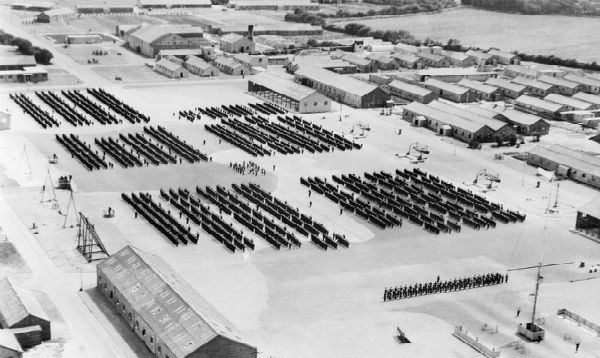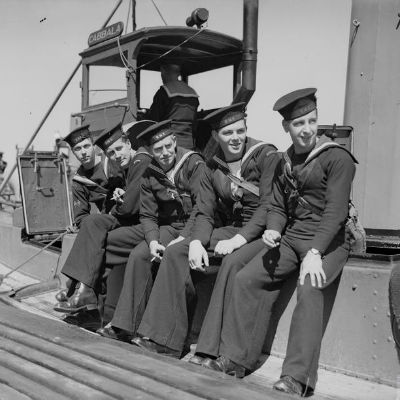According to the landowner, it was ‘the finest bit of corn land in the south of England‘. Locals would call it the best snipe marsh in the country. It was certainly boggy and sea boots were compulsory wear for trainees who strayed from the paths. HMS Collingwood opened in January 1940. Built on 190 acres of marshy Hampshire land, it provided basic training for Hostilities Only ratings.
The Navy continued their tradition of naming shore establishments or ‘stone frigates’ after sailors of renown. This quirk of naval nomenclature began in 1803 when Commodore Hood, when mounting cannon on the strategic Diamond Rock off St. Lucia, commissioned the island as HMS Diamond Rock
It was Vice-Admiral Collingwood (left) who lead the lee column of ships at Trafalgar. Admiral Nelson led the weather column in HMS Victory. Upon Nelson’s death, it was Collingwood who commanded the British fleet to victory aboard his flagship HMS Royal Sovereign.
Born in Newcastle-upon-Tyne, his home town erected a monument in his honour, overlooking the river at Tynemouth. The cannon flanking its base came from the Royal Sovereign.
Hostilities Only men arrived at HMS Collingwood by train after what must have been a daunting journey on Britain’s blacked-out wartime railways. They were met at the station by their Petty Officers. HMS Collingwood was well planned with wooden accommodation huts mounted on concrete plinths to prevent the ingress of water and spread out to reduce the number of casualties in the event of an air raid.

The parade ground HMS Collingwood © IWM A 18929
In 1943 a single bomb scored a direct hit on one hut killing thirty-three young sailors inside (covered up during the war as an ‘ammunition accident’ for propaganda purposes.
Ratings received obedience training, seamanship skills, foot drill, practical demonstrations and physical instruction. FS Holt of the Australian Naval Volunteer Reserve found the system frustrating:
The system at Collingwood was geared for new recruits. By necessity it proceeded at the speed of the lowest IQ. Our early period of training was often boring.
FS Holt
Each section had its own administration office, junior rates and petty officers accommodation, drill shed, boats and davits. The dining hall would seat 600 men. Housing 2,500 Hostilities Only ratings in each section meant HMS Collingwood accommodated a total of 10,000 men each following their ten-week seamanship course.
The 1939 Seamanship Manual became the Ratings bible, unlocking the confusing world of naval ranks, branches & knots. How to sail a dinghy, row a boat or steer a ship. Due to operational demands, Ratings may have seen warships in the distance but rarely set foot on one.
Each gymnasium contained a large cylindrical water tank across which every new entry had to flounder, wearing an inflatable lifebelt in which, it was hoped, he would gain some confidence before experiencing the real thing.
Every batch of new arrivals would be photographed and their names & home-towns faithfully recorded.


Upon completion of basic training, the men left HMS Collingwood as Ordinary Seamen or ‘men not fully trained, but generally employed at sea.’ They would part company with friends and travel to new bases, specialising in their chosen branch; gunnery, fleet air arm, navigation, anti-submarine or torpedo.
The Visual Signallers of the Communications Branch were no exception but this training continued at HMS Collingwood. HMS Collingwood continued to train visual signallers and Wireless Telegraphy ratings throughout 1942. A Radio Direction Finding school was later added reflecting the rapid advancement of the technological war. Today it belongs to the Maritime Warfare School, the largest naval training organisation in Western Europe.
But back in 1941, Ordinary Seaman Brooks wasn’t going anywhere.








'HMS Collingwood' have 2 comments
3rd March 2023 @ 8:47 pm James Walters
Incredible how many men they were pushing through Collingwood. Do all of the class photos still exist?
I am researching Joseph Percy Hearne from Grendon Underwood. He was at Collingwood from 12 August 1941 through until 22 October 1941. Would love to know if we could find his photograph
13th September 2023 @ 11:47 pm Stephen McErlain
Trying to discover names of training officers and personnel in Glasgow at Sherbrooke House (HMS Marryat) from 1942 through 1946.